Tropica Nursery's Adeniums
I (Ashish Hansoti) saw my first Adenium in 1980- my uncle had bought one for Rs.400 (then about $25) and I was attracted by both, the plant and the obvious business potential!
I bought my first mother plants in 1981 and was trying to figure out the hand pollination procedure before long. Some effort and abstracts of articles describing this allowed me to produce Adenium seeds, which I began selling in 1983 or so.
Sometime later I received habitat seeds of Adenium obesum and A. swazicum and crossed these to get my first hybrids, including Asha (which is one of the largest Adenium flowers but too floppy in our heat) and Miss India.
All this was happening on various terraces and spaces that I was able to wangle in Bombay city. The weather here is almost perfect for Adeniums, except in the monsoon- every year this period of prolonged heavy rain would claim its victims till I dreaded its arrival. Without plastic cover and systemic fungicides we were helpless and watched in dismay as large specimens and new hybrids fell to stem and caudex rot.
My first visit to Bangkok in the early 90’s was an eye opener- I saw for the first time how much variation and potential there was amongst Adeniums as well as Euphorbia milii hybrids. Bangkok’s Chatuchak weekend market was, and still is, a plant collectors dream. I spent large sums of money over several trips collecting Adeniums, Euphorbias and other plants. Some of these Adeniums are no longer to be seen in Bangkok and maybe I have the only surviving examples of these slow growing but very distinct clones.
The purchase of a small piece of land outside Bombay (now Mumbai) in 1994 allowed me to shift all my plants and have enough space for the first time. I also built my first plastic houses which meant we could carry plants through the monsoon with few losses. Seed production increased and was one of the few sources of revenue. We made a few crosses but the fact that I did not stay with the plants, as well as preoccupation with more lucrative and "real†businesses including HOSCO (making plastic pots and grower supplies) in the city, kept me constrained.
My growing was still a hobby- we sold only Adenium seeds. A trip to Bangkok just before I got married, in 1998, opened my eyes to the possibilities in producing grafted plants. We acquired substantial mother stock of about 20 cultivars and started producing plants.
Things have moved rapidly since - I have made over 20 trips to Bangkok and several to other places of Adenium interest- USA and Taiwan. A lot of new material was introduced and is now in the trial and stock build-up phases. Many crosses were done and selections made- we believe these are already outstanding but only a fraction of all there is to come.
We now have about 2 acres of land, mostly under simple plastic cover devoted to growing about 150 distinct, superior Adenium cultivars and hybrids. We grew about 100,000 grafts last year and produced over a million seeds. Trial shipments of bare root plants to the USA, Canada and Europe have gone well.
Over the next few years, I hope to introduce large numbers of superior selections to collectors and, by making suitable selections, I hope we can make Adeniums a more mainstream floriculture crop.
The explosion in interest in Adeniums is primarily due to the selection of superior cultivars and the breeding work undertaken to give us hundreds of hybrids.
One must understand, however, that all Adeniums grown from seed are "hybrids†in that the plant rarely self-pollinates and that each seedling is distinct. I have known one grower to claim he had a collection of a thousand hybrids – he counted each plant in his collection as a separate hybrid and considered minute differences between the leaves, flowers, and growth habits as significant. Luckily, he did not proceed to name the plants!
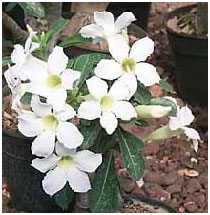
When I was first offered this white flowered Adenium, I flew to Singapore just to pick it up.
In the early days of Adenium breeding and selection it was exciting to find the first white or red flowered Adenium. However, lately there has been considerable inter breeding amongst the selections so that many traits will breed quite true and give seedlings of excellent quality- for example several Taiwan red hybrids will give 100% seedlings with red flowers when crossed. It then becomes imperative for the breeder to be very cautious when naming a new hybrid for vegetative propagation- it must show substantial improvement over existing hybrids before being selected and named.
This is not very easy as few breeders have access to a wide range of material for comparison. Even in Taiwan, which has more real breeders than anywhere else, there are two or more groups of growers, and one group has little access to material from the other groups.
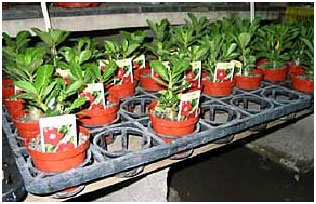
Taiwan is far enough in Adenium breeding to have seedlings from specific crosses being sold, often with a color label. This level of marketing is seen only with orchids.
A person growing Adeniums from seed can get really excited about a new seedling, not realizing that some much superior material with similar characteristics is already available. Conversely, it is very much necessary that clones similar in most ways but particularly adapted to certain cultural conditions (e.g., cold weather tolerance) or diseases are selected- they may then be used to replace otherwise similar older hybrids.
The only real way past this problem is to be very circumspect when naming and releasing clones with characteristics already well represented, e.g., typical A. obesum crosses with A. swazicum. A reference collection in various countries or under different cultural conditions would go a long way in preventing new but inferior material from being released. One of these reference collections would also serve as a registering authority for new hybrids.
Large collections and nurseries offering scores of hybrids rarely make the effort to really grade their hybrids and there is a great risk of collectors getting stuck with material that is not worthwhile. The initial cost is the least of the problems- since most people can only grow a limited number of plants it’s the opportunity cost which is the greatest loss.
When introduced as a floriculture crop, the intrinsic qualities of the hybrid will often quickly determine its success: the superior Thai cultivar Chomphoo Samran has become a staple in the Bangkok potted Adenium trade rather rapidly after its introduction.
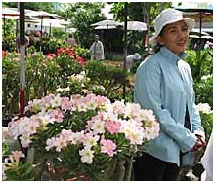
Chomphoo Samran on sale at Bangkok's Chatuchak weekend market.
The following are some notes and observations on the various Adenium Groups & Categories: these are based on the Classification system described in detail under Adenium Classification:
At the current level of hybridization, the species involved are still obvious- depending on the most prominent species, we can group all selections but no doubt this will have to be modified as more complex hybrids make it difficult to segregate them into these groups.
This is the basic species, and most selections and hybrids would go under this group. It contains a vast range of clones in various flower colours, leaf forms etc.
Till about the early 80’s, there was hardly any selection in the flower types amongst A. obesum clones- maybe some were grown for large flowers or for being extra floriferous but that’s about all. Since then, there has been an explosion in the assortment of flower colour available through other flower characteristics like double flowers or newcolours like yellow continue to elude us so far.
The main colours available include:Many pure white, albino clones are available. These totally lack any red pigmentation and have no red in the throat or anther tails, new growth is green without any red tinge and seed hairs are white. These clones do not necessarily breed true though some do. Flower size varies from small to large, with the best clones having medium large flowers in clusters such as the Thai cultivar Moro Lok Dok.
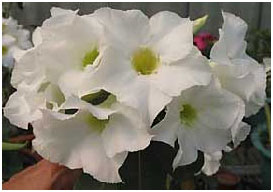
A new, unnamed and unreleased white with large, full form flowers of exceptional substance.
Problems with whites include extreme susceptibility to spotting due to any type of sprays, especially some insecticides and micronutrients. Future selections should aim for some improvement here as well as the usual: better form and substance, long flower life etc.
One characteristic unique (so far) to white is mild fragrance- there are certainly several clones that have a slight fragrance to newly opened flowers. Unfortunately, I am "olfactorily challenged†and haven’t given much attention to this factor- strongly scented flowers would be a bonus.
These are any flowers that are less than pure white and going on to being pastel colored, usually pastel pinks but also creams. A classic example would be Chomphoo Samran. Several clones have flowers that open almost white but slowly develop a pink to red blush to varying degrees (such clones may be called "Changeablesâ€).
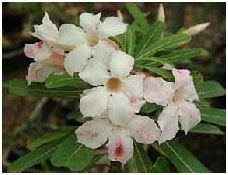
An old Thai cultivar (whose name I have lost) has large flowers that open pure white and slowly change to pink- the colour can get quite deep under some conditions. This is one of the Changeables that go from white to pink.
Pink is the species color of A. obesum and so selections with this basic color must excel in most other characteristics. A good example is Nung Deo – the flower form of this clone is exceptional, it is floriferous and has deep green, shiny leaves.
New pinks must have all the above with additional characteristics such a compactness, bright, clear pink color etc.
Red colored Adenium flowers have been around for a while (the prefix Daeng means Red in Thai) but continued selection and breeding in Taiwan has led to a huge range of hybrids all with reds in different shades. This is where a RHS color chart would be really handy as it is difficult or impossible to describe the various shades- some of them are really distinct.
There are a lot of problems with existing reds- this is partly intrinsic to red hybrids in many different flowers including roses and partly a legacy of poor selection during the early stages- people were so excited by the deep red flowers that they neglected other aspects.
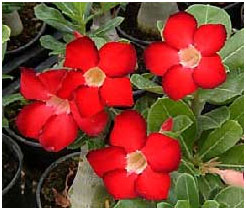
The cultivar Arrogant, arguably the best red Adenium available in the trade today.
The above are the most common problems to look out for in red hybrids; one must, of course, always try and select for the usual positive characteristics. The most popular Taiwanese red clone, Arrogant (which I think is the same as Tender, another Taiwanese red) overcomes all the above short comings of red hybrids to a great extent.
Almost all "purple†flowered clones are of Thai origin, where the Thai word "Muang†meaning violet is used. Many years ago, they created quite a sensation but haven’t really lived up to their promise. I feel there is a certain amount of A. somalense var. somalense component in many though not all purples. Many of the problems that affect the reds also affect the purples- flower fading is particularly severe.
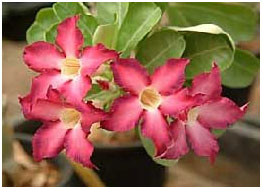
A new purple seedling with Blue selects as one parent, showing little or no fading of flowers with age. This is an unusual case with purples
There is no doubt a distinct color possibility here; some clones like Muang Madam have particularly clear coloration. We have some clones which fade very little but flowers are still small and plants don’t flower too freely. More work and selection is needed.
Almost all the purples are also rather rank growers with large leaves and lanky growth and require hard pruning once a year to keep in check.
Patterned Adenium flowers are any that have a strong and distinct pattern on the flowers; this may be in the form of a central star, a picotee pattern (white with dark border) or a lighter border around a darker flower. Other patterns may emerge in the future. All these add considerable interest to the flower and are welcome additions to the range.
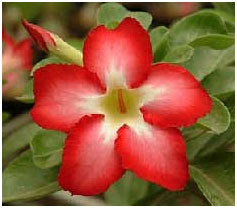
One of several new selections with central star pattern: this one has decent form and heavy petal substance, but the star is not very distinct or bright and the variety is not good enough to be named and released.
Flowers with a central star such as Universal Star seem to be of Thai origin and are basically the color of the throat pouring onto the petals. Currently all selections have poor flower form, and they are not floriferous, but we do have some very bright and eye catching selections.
Picotee is the normal pattern for A. multiflorum flowers and is an extremely eye-catching coloration. Several attempts have been made by me and possibly other to combine the flower pattern and mass blooming habit of A. multiflorum with regular blooming habit of A. obesum. None have succeeded but we do have a fabulous picotee of unknown origin: Noble Concubine from Taiwan. It is an extremely floriferous, eye catching hybrid that flowers profusely for 3-4 months in winter-spring and intermittently through the year.
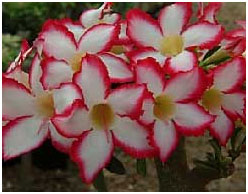
Wow! - the most obvious response to a Noble Concubine in full bloom. The fortunes of one of the best Adenium nurseries in Taiwan started with this one selection.
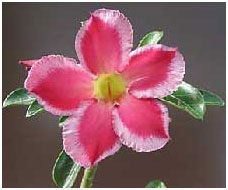
A considerable improvement over currently available hybrids with bordered flowers- we need to see how floriferous it is as well as judge it for other characteristics besides individual flowers.
Bordered flowers are of Thai origin, with Daeng Siam being a very good example. The word Daeng means red in Thai, but the flower is a bright orange pink (really need the RHS color guide here!) These bordered flowers are also very eye-catching and usually have distinctive bluish foliage. Further selection to improve flower form, avoid color fading etc is needed.
A category for placing items that won’t fit into the above- maybe a yellow some day! Some work in this direction is being done using off white flowers. One thing I have noticed is that often-young white flowered seedlings will show considerable yellow coloration, but this disappears once the plants are older and flowering regularly.
Many Adenium selections have been made for unusual leaves, mostly different types of variegation. Apparently, Adeniums seem to give variegated sports rather easily and quite a few exist.
One interesting characteristic of variegated Adeniums is their vigor- for most plants, highly variegated sports are generally low on vigor and disease prone but not so with Adeniums- most variegated clones have strong growth characteristics.
The type, extent and color of variegation vary widely Thai growers have been particularly adept at selecting for variegation and new sections keep appearing every year (the Thai word for variegation is Daang, very close to Daeng which means red). Some clones have been selected for bright, outstanding variegation; some have good flowers in addition to the variegation while a few are variegated sports of hybrids already selected for superior flowers (such as Black General Variegated).
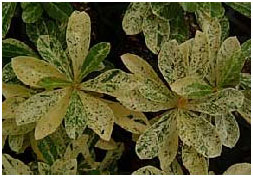
A recently released, new Thai variegate called Princess Beauty. Besides being highly variegated, the stem and leaves show a lot of pink tones. Add the pink flowers and you have a particularly colorful cultivar.
At least two variegated clones with white flowers are known to me, one with very bright variegation called White Jade. Several variegates including this one has leaves stippled or spotted with white or cream- this can be extensive enough to give almost totally new white growth. Leaves then slowly turn green. This gives an extremely attractive look to selections such as Khao Sala Phat Nung but to most non collectors and horticulturists unfamiliar with it the plant looks like it is in an advanced stage of spider mite infestation, so I guess its floriculture potential is limited!
Any plants with distinctive leaves but not variegated. Currently there is one obesum with distinctly colored leaves- Nila Kaan with reddish green to burgundy leaves. No doubt a golden leaved cultivar will turn up sooner or later as it has for many cultivated plants and indeed for Adenium arabicum.
We have one plant with distinctly heart shaped leaves- Valentine – but other plants with distinctive leaf shapes will also fall into this subcategory.
Compact, branching growth is a highly valued characteristic for Adeniums and is one of the traits to look for when selecting new hybrids but these would not be put into this category.
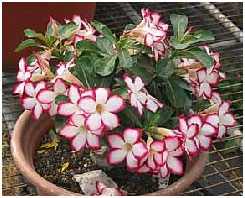
Taiwan Dwarf: the other genetic dwarf. This is a very special clone of this as it has picotee flowers. The Taiwan dwarf strain is special in being less distorted and in having flowers of normal or even large size.
There are, however, some A. obesum clones selected primarily for dwarf characteristics; a typical example would be the selection called Mombassa, which is a compact, small leaved and heavily branched plant with very attractive over all plant form. There are also at least two extremely compact genetic dwarf forms of Adenium obesum. These come true from seed and at least the Thai form (Khao Kae) seems to have a simple recessive gene for this trait and is inherited in classic Mendelian ratios.
All other growth forms such as crests or monstrose clones would come under this subcategory. There are several such clones available though few of them flower.
This is a residual category to hold any future hybrids that do not fall in any of the above categories.
Adenium swazicum was used in intergeneric hybrids with A. obesum over 20 years ago and some of the most floriferous hybrids belong to this group. A. obesum is usually the seed parent because of the difficulty in setting seed on A. swazicum.
Current swazicum hybrids are still very recognizable as such- traits include short, clustered anther tails; dark purplish throat coloration; long narrow somewhat hairy leaves and other characteristics that are a bit difficult to describe but obvious to the experienced observer.
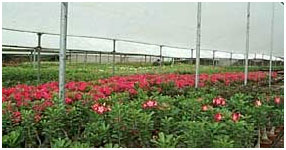
The swathe of pink in the middle is a bench of Miss India: this extra floriferous clone stands out amongst all the Adeniums at Tropica Nursery, being always awash with color.
Swazicum hybrids are particularly floriferous- in fact the most floriferous Adenium I know - Miss India- is a first generation swazicum hybrid. Many hybrids have a different kind of elongated inflorescence that continues to bloom for months and almost all the good ones will show a new inflorescence developing before the current one is spent.
Flowers of A. swazicum hybrids range in color from light pink to red but newer hybrids show very attractive pastel colors. I am sure further breeding will increase the range of available colors like A. obesum. With this hope we retain the subcategories used in A. obesum for A. swazicum hybrids too.
This relatively new variety is causing quite a stir amongst Adenium breeders- it introduces patterns and venation in the flowers not seen before. In the best hybrids it also produces compact plants with large clusters of flowers and attractive leaf forms. Unfortunately, the novelty of these hybrids has meant that all sorts of very mediocre material is being sold for high prices.
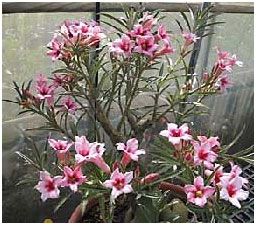
A new crispum hybrid in Taiwan: this one is better than most being sold there for quite high prices. I would prefer to have more compact growth in crispum hybrids.
The one big disadvantage in using crispum in breeding is its quilled petals (in fact it gets its variety name from this characteristic). Most hybrids exhibit this characteristic to a greater or lesser extent and even though flowers may open with good form, they develop the twisted petals with age.
The other negative- small flower size- is not so difficult to overcome and with further crossing and selection it should be possible to get bigger flowers: indeed, some of the better hybrids already have flowers like average A. obesum flowers in size.
Overall, current selections are more interesting for the promise they hold rather than actual caliber- it is my impression that most crispum cultivars look better in photographs than in real life.
Every attempt must be made at this stage to stop introducing generic crispum hybrids, some with a combination of the worst characteristics of both species: tall lanky plants with small nondescript flowers of poor form showing minor crispum markings on the petals. The compactness of A. somalense var. crispum and its leaf forms must be part of the hybrids of the future, along with very distinctively marked flowers in bunches on floriferous plants.
There are few cultivars or hybrids amongst the other Adenium species, either because their basic characteristics are not superior enough to warrant their use in breeding or the better characteristics (such as the growth forms of A. arabicum) cannot be reproduced easily by grafting, the preferred and practical mode of propagation for most Adenium selections.
A few selections that come to mind are mostly A. arabicum, such as Golden Crown, a seed grown selection with well-developed caudex topped by multiple short branches. It does not breed true yet, but I suspect superior seedlings are selected and grown. Prices vary from plant to plant depending on plant form.
A most interesting clone is the golden leaved mutant of A. arabicum called Golden Dragon. This hybrid is very slow growing and likely to remain a rare collector’s item.
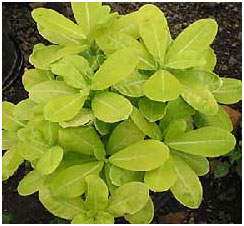
The only yellow leaved mutant amongst Adeniums so far- Golden Dragon. It is a sport of Adenium arabicum and occasionally gives typical arabicum flowers.
The other Adenium species probably contributed to some hybrids, but this is neither documented nor obvious. Two possibilities are A. bohemianum in the very beautiful hybrid Beautiful Lady and A. multiflorum in Noble Concubine. But till this contribution is confirmed we would have to treat these very superior hybrids as A. obesum.

© Copyright Tropica Nursery 2025. All Rights Reserved.
Maintained by MiracleworX Web Designer Mumbai